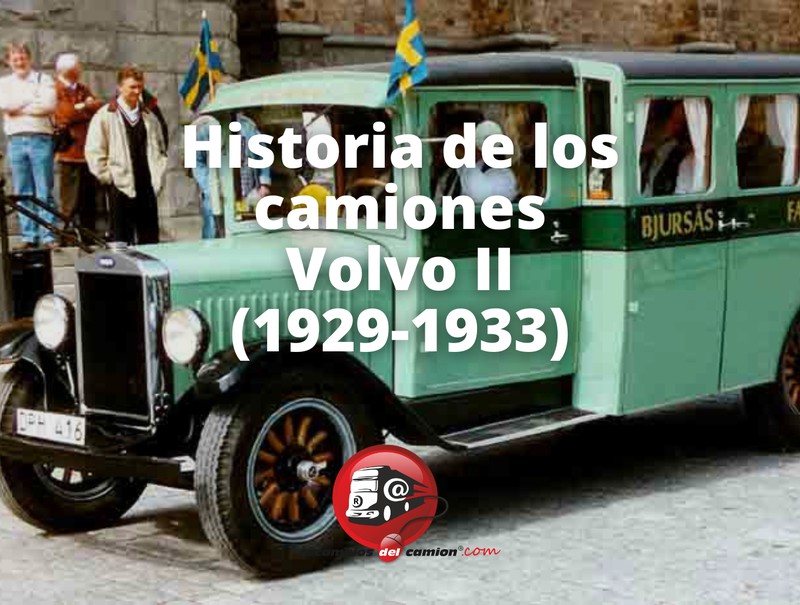History of Volvo II trucks (1929-1933)
We continue with the summary of the interesting history of the Volvo brand, focusing on its section dedicated to trucks. In this article we talk about the 2 Series, the LV60 and the brand's first heavy truck, the LV60, which offered the Hesselman engine as an option, a hybrid between a gasoline engine and a diesel engine.

After the success achieved with its first truck model, the Volvo 1 Series, the brand decided to improve it with the launch of the 2 Series.
Back then, the roads were dirt roads, used mainly by cars, with a track width greater than the wheelbase of the Series 1. Specifically, the cars left ruts on the roads at 1.5 meters of distance between wheels and the first Volvo truck measured 1.3 m. between wheels. This made it very difficult to drive the 1 Series on these roads.
For this reason, the new and improved model widened its track width to 1.46 meters, placing the rear leaf springs outside the chassis spars. In addition, production costs were optimized, lowering its sale price compared to the previous model, and the wooden steering wheel was changed to a bakelite one.
It was a very successful model too, maintaining the simplicity, strength and reliability of the Series 1. But it still had the same low-powered engine which, in this model, gave a lower top speed, although with a higher load capacity.
They were widely used by bus companies that built the chassis of the 2 Series with a wooden body covered in sheet steel.
A few months after the launch of the 2 Series, Volvo continued to innovate to improve the performance of its trucks. Aware of the lack of power of its previous models, it launches the LV60 series, which went from Volvo's original 4-cylinder engine to a 6-cylinder one. It also introduced the four-speed gearbox.
The first LV60 had 55 CV of power and in a later redesign of the engine it increased 10 CV, reaching 65 CV, thanks to the increase in displacement, from 3010 cc to 3366 cc.
The arrival of the LV60 also brought the name change of the 1 Series, which became the LV40, LV41, LV42 and LV43, giving names to its variants with different wheelbases and gear ratios, and of the Series 2 that were renamed LV44 and LV 45.
The launch of the LV60 eclipsed the success of the 2 Series, causing the latter to take a year to sell the 500 units produced, twice as long as it took the brand to sell the first 500 units of the Series 1.
In 1931, Volvo launched its first heavy trucks. Unlike previous models, it is designed from scratch, with its own components and not based on the brand's car models.
The LV66 series is launched with four variants: the LV68 and LV69, with a payload of 3.25 tons, and the LV66 and LV67 with a payload of 3.5 tons.
The new engine that they mount already reaches 75 CV of power, going from flat-head engines, which located the valves under the combustion chamber, in the engine block, to valve engines in head (OHV), with the valves located in the cylinder heads, with rods that moved them from the camshaft of the engine block.
It also incorporated other great innovations such as a new, heavy-duty four-speed gearbox, the replacement of wooden wheels with steel wheels and the introduction of hydraulic brakes.
In 1933 the option was given to increase the load capacity of the LV66 and LV67 up to 5.25 tons, thanks to the incorporation of a trailing axle. The LV70 is also launched, with a long wheelbase, widely used as a bus and as a fire truck.
Also in 1933 it was offered to equip a Hesselman engine as an alternative to the gasoline engine. This gasoline/diesel hybrid engine was invented by another Swede, engineer Jonas Hesselman in 1925 and was the first to use direct injection in a spark ignited engine.
They incorporated a combustion process with regular compression of the intake air. Fuel was injected directly into the combustion chamber at the end of the compression stroke, near TDC. Due to the low compression, the inhomogeneous mixture of air and fuel had to be ignited with a spark plug.
These unique features allowed it to run on heavier and more economical fuels. In fact, it was capable of running on oil, kerosene, gasoline or diesel. And it had a lower consumption than gasoline developing equal powers. Compared to diesel engines, they were smaller and less heavy than these. With subsequent improvements in metalworking manufacturing processes, diesel engines became considerably lighter and Hesselman engines fell out of favor.
The main disadvantage of these hybrid engines was that, due to its low compression, it was difficult for it to reach the optimum working temperature, producing incomplete combustion that quickly fouled the spark plugs and produced dense and highly toxic smoke. due to the arrival of a part of the unburned fuel in the exhaust system.





Receive our news